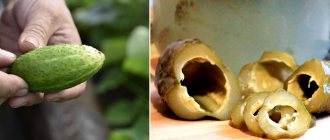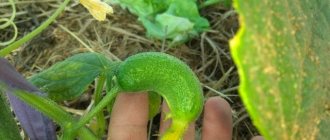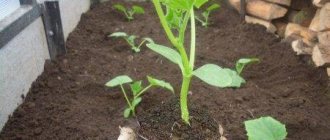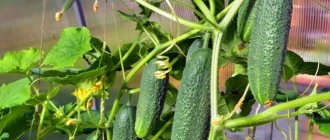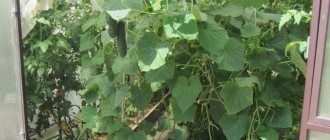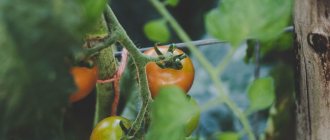Author's rating
Author of the article
Yakov Pavlovich
Professor, Head of the Department of Vegetable Growing
Articles written
153
The question of why cucumbers do not grow and bear fruit worries many summer residents. There can be many reasons for poor growth of cucumber crops. To understand the problem and solve it, we need to consider the conditions for the growth of culture. The yield of plants depends on the conditions; you need to pay attention to it first. Let's consider all the reasons for insufficient growth of cucumbers in more detail.
Reason 1 – low temperature
Cucumber is a heat-loving crop. The optimal temperature it needs for normal development is 23-25°C during the day and 15-18°C at night. At temperatures below 14°C, the growth processes of cucumber vines are suspended.
It has been noticed that the plant grows at night. For this reason, a decrease in night temperature to below 14°C (and this phenomenon is not uncommon in the middle zone in June) leads to the fact that the bushes stop growing.
What to do?
If your cucumbers grow in open ground, then during cold weather, install arcs over them and cover them with film or any non-woven material. This technique will protect the plantings from low night temperatures. If the temperature drops significantly at night, you can place bottles of hot water on the beds. This method is also suitable for greenhouses.
Why do cucumbers not grow after planting or sprouting?
Before looking for feeding recipes, you need to understand the reason why cucumbers do not grow at all or grow only poorly.
There may be several reasons:
- After planting in the garden, cucumber seedlings need 7 to 14 days to take root. It all depends on the age of the seedlings, in what soil it was planted, on the air and soil temperature. There is no need to wait for new leaves to appear in 2-3 days. Seedlings need time to take root.
- One of the main reasons why cucumbers may not grow well is low air and soil temperatures. The optimal temperature for their development is +15 degrees and above. Otherwise, the shoots or planted seedlings will simply “freeze.” Until the earth warms up, no matter what you feed the cucumbers with, they will not grow.
- Many gardeners know that cucumbers need nutrients for good development. They will not grow well in poor soil.
Note! That any fertilizers and folk remedies should be fed only when it is warm. They will not be absorbed in cold soil. So wait for it to warm up first.
Reason 2 – lack of moisture
Cucumber is not only a heat-loving plant, but also a moisture-loving one. Insufficient soil moisture often causes the growth of bushes to stop. This is especially true for sandy soils, from which moisture evaporates very quickly.
What to do?
Adjust the watering schedule. Cucumbers growing in open ground are watered every 1-2 days during periods of drought. The amount of water should be enough to wet the soil to a depth of at least 10 cm - this is where most of the plant’s root system is located.
For greenhouse cucumbers, watering should be even more frequent. Typically, plants in a greenhouse are watered every day, on the hottest days - twice a day, early in the morning and late in the evening.
Water the cucumbers with warm water that has been left in the sun. Its temperature should not be lower than 18°C.
- How to water cucumbers correctly for a good harvest
Everything you need to know about watering cucumbers, depending on the time of year and growing conditions.
Analysis of the issue of pollination of cucumbers in a greenhouse
When purchasing seeds for planting cucumbers, you need to pay attention to the method of pollination. If the variety is pollinated, problems may arise with the harvest, because insects do not have free access to the greenhouse. Therefore, it is necessary to buy seeds whose packaging has the designation F1 - they are self-pollinating. In addition, such varieties germinate well and produce an excellent harvest.
Before planting the seeds, they must be sorted. To do this, prepare a 5% salt solution and pour it into the planting material. Those seeds that float to the surface will not be useful - they are empty inside and will not sprout. The rest are soaked for 15-20 minutes in a weak solution of potassium permanganate. After this, they need to be washed and soaked.
If a gardener is faced with a pollination problem, when similar varieties are already growing in the greenhouse, it is necessary to attract insects as actively as possible. To do this, on warm days, open the windows and doors. You can plant flowers next to the cucumbers that are interesting to insects. Marigolds, mint or lemon balm are suitable. In addition, it is possible to pollinate cucumbers yourself by picking a male flower and rubbing it against a female one.
Reason 3 – lack of nitrogen
Another reason that cucumbers do not grow is a lack of nutrients, most often nitrogen. It is this element that is “responsible” for the growth of green mass. Its deficiency will also be indicated by pale, sometimes yellowish, leaf blades and thin, hard lashes.
What to do?
If the reason for stopping the growth of cucumbers is a lack of nitrogen, then you should feed the plantings with mineral or organic fertilizers with a high content of this element.
Urea will cope with this role perfectly : 1 tbsp. Dissolve fertilizers in 10 liters of water and treat the plants leaf by leaf.
Followers of organic farming can use chicken manure . To prepare an infusion, fill any container 1/10 full with chicken droppings and add water to the top. Stir the contents regularly for 2-4 days, and then dilute the prepared fertilizer with water at a rate of 1:10 and water the plantings. The norm is 0.5-1 l per bush.
You can also use mullein solution : dilute 0.3-0.5 liters of organic matter in a bucket of water and water the bushes. The norm is 1 liter per plant.
Nitrogen fertilizer can also be made from nettles or other herbs. To prepare a herbal infusion, fill a third of the container with herbs, fill it to the top with water, place in a warm place and leave for several days. Then dilute with water at the rate of 1 part of the infusion to 5 parts of water and water the plantings with this fertilizer.
- How to feed cucumbers for good growth
If you do not want to use chemicals for feeding, they can be easily replaced with improvised means.
Soil composition: what should it be for cucumbers in a greenhouse
When planting cucumbers, it is important to take into account all the nuances. For example, remember what plants grew in this area last year. It often happens that predecessors deplete the soil and cucumbers lack essential minerals and trace elements.
In addition, do not lose sight of soil disinfection. It may contain pest larvae, harmful bacteria, and fungal spores. All this can not only deprive you of your harvest, but also destroy the seedlings. Therefore, before planting, it is worth disinfecting the soil by watering it with a solution of potassium permanganate.
If the seedlings have already been planted, it is important to feed them on time. Mullein solution is perfect. You need to take 1 liter of slurry per bucket of water. It is necessary to take precautions when applying nitrogen-containing fertilizers, since their excess provokes the growth of leaves and inhibits the formation of fruits. If the soil is already saturated with nitrogen, it can be neutralized by adding potassium and phosphorus fertilizers.
Reason 4 – dense plantings
The optimal distance between plants will differ for different varieties of cucumbers. On average, plants are planted at a distance of 30-35 cm - in a row and about 70-80 cm - between rows. Trying to use every meter of a small plot usefully, summer residents often plant cucumbers too close to each other. This may cause plant growth to stop. The fact is that if the bushes are planted too densely, they receive insufficient light and air, which slows down their development. In addition, due to poor ventilation, plants are more often exposed to diseases and pest attacks.
What to do?
There are two possible solutions to the problem:
- Thin out the seedlings by removing excess plants. You can try to transplant the excess seedlings to another place, but cucumbers tolerate transplantation very poorly, so there is little chance that the transplanted plant will be accepted and produce a good harvest.
- In order not to pull out the seedlings, but at the same time provide them with enough light and air, try growing cucumbers vertically - on a trellis.
Vertical cultivation, according to those who use it, is definitely better than growing cucumbers in the traditional way - spread out. The main advantages of the trellis method:
- cucumbers are evenly illuminated by the sun;
- It is much more convenient to collect fruits than from vines lying on the ground;
- plants are easier to care for;
- You can get a rich harvest from a small area.
Useful tips for gardeners
Experienced gardeners know many techniques on how to stimulate the growth and fruiting of cucumbers.
They recommend:
- To prune the bushes: pinch the main stem at a level of 1 m, and additional vines at 40–60 cm. This is necessary, since the fruit buds are tied on the side vines. Without pinching, many small fruits may set, but they will not have the strength to grow.
- Harvest on time. If this is not done, ripe cucumbers will take all the plant juices. The embryos of new greens will appear, but they will hang small and will not be able to fill out.
Everyone's favorite cucumbers are quite fancy vegetables. Only by properly caring for them can you get a bountiful and high-quality harvest of healthy vegetables.
Reason 5 – lack of light
The reason for the slow growth of seedlings may also be the wrong location for the cucumber bed. Optimal development of this crop is possible only in a sunny area, protected from strong and cold northern winds. Cucumbers can grow and bear fruit in partial shade, but the yield will be lower than in sunlit beds.
What to do?
Do not plant cucumbers in the shade of trees, bushes or near tall plants. If it turns out that neighboring tall plants create shade for the cucumber bed throughout the day, try to get rid of them.
A dense wall of tall or climbing crops: sunflower, corn or beans, planted on the north side of the cucumber bed, will help protect the plantings from strong winds.
Damage during transplantation
Due to their delicate root system, cucumber seedlings are not recommended to be planted. Transplanting indoor seedlings into a greenhouse becomes stressful for the plants. They stop growing for a while, and this entails a delay in fruiting.
To prevent the situation, it is recommended to grow seedlings in peat cups or sow the seeds directly into the greenhouse.
Reason 6 – incorrect formation
Excessive green mass of the plant can also lead to growth stagnation. There is no consensus among gardeners regarding whether to remove stepsons on cucumbers or not, or how to shape cucumbers - into one vine or several. However, perhaps everyone agrees on one thing: the cucumber whip needs to be “blinded.”
What to do?
What is "blinding" of cucumbers? This is the removal of everything up to a height of 4-5 leaves: ovaries, stepsons, tendrils and leaves. This technique accelerates the development of the cucumber bush, simplifies its care and inhibits the development of diseases.
We wrote earlier about various ways to form cucumbers.
- Forming cucumbers: how and why it should be done
Is it worth pinching cucumbers and how does this affect the yield?
Poor quality seed material
Poor quality seed material will not sprout
Before sowing, cucumber seeds must be carefully calibrated and checked for hollowness.
Before disembarking:
- inspect the integrity of the seed shell;
- soak them in salt water for 5 minutes: the pacifiers will float;
- germinate a few selected seeds. If they sprout, the whole batch is ready for sowing.
Attention: to increase the likelihood of self-collected seeds sprouting, the seeds are soaked in a humate solution for 12 hours before sowing.
In addition to the quality of the seeds, it is necessary to take into account the age of the seed. Cucumbers are never planted in the first year of seed collection. They practically do not sprout. Seeds of the second, or even better, third year are more productive.
When sowing overripe seeds, you should also not wait for friendly shoots. It must be taken into account that after the third year of harvest, germination rate drops by 4-5% in each season.
Pests
Pests can hinder the growth of cucumbers. In this case, the plant leaves are damaged and insects or their larvae may be present.
If cucumbers are attacked by spider mites, it is difficult to notice them in the early stages. But its presence can be detected by a coating that glitters in daylight.
Insecticides and herbicides are used to control diseases and pests. You can also use folk remedies, which is most important during the fruiting period, when it is not recommended to use chemicals.
Diseases
It is not uncommon for various plant diseases to cause poor growth of cucumbers. You can figure out the specific reason for the poor growth of cucumbers using different symptoms.
For example, when rot develops, wet spots of different colors appear on the plant. The disease begins to affect plants from the root, moving to the top.
When powdery mildew becomes the cause, a white coating is visible on the leaves. When cucumbers are infected with angular spot, olive-colored spots appear on the underside of the leaves.




